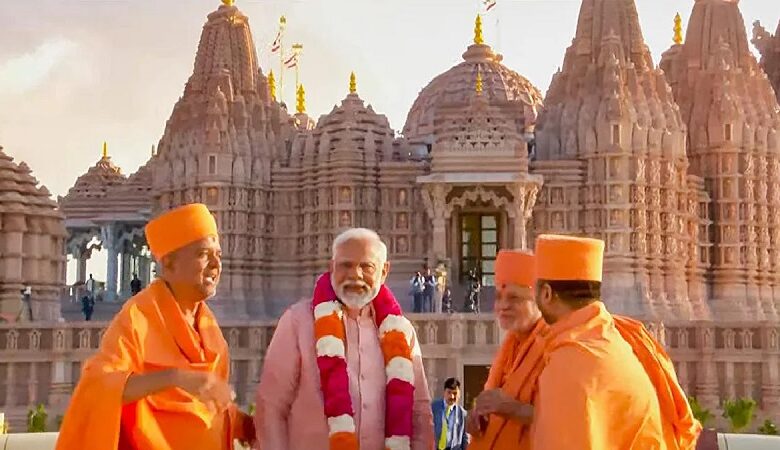
Prime Minister Narendra Modi on February 14 inaugurated the first Hindu temple in Abu Dhabi, a day after he in the United Arab Emirates (UAE) for a two-day official visit.
The BAPS temple will be enduring tribute to the values of harmony, peace and tolerance, which both India and the UAE share, Modi said in his departure statement.
The BAPS temple
Located in the Abu Mureikhah district, the temple, built by the Bochasanwasi Akshar Purushottam Swaminarayan Sanstha (BAPS), is spread across 27 acres of land gifted by the UAE leadership. In 2015, Sheikh Mohamed bin Zayed Al Nahyan, the Crown Prince of Abu Dhabi and Deputy Supreme Commander of the UAE Armed Forces, donated 13.5 acres of land for the temple.
The UAE Government, during its Year of Tolerance, allocated a further 13.5 acres in January 2019, taking the total gifted parcel to 27 acres.
Built at the cost of Rs 700 crore, the temple is 108 feet high, 262 feet long and 180 feet wide.
Reportedly, more than 20,000 tonnes of stone and marble was shipped in 700 containers to Abu Dhabi for the temple. There has been no use of steel or iron. Fly ash has been used to fill up the foundation, replacing 55 percent of the cement in concrete mix, reducing the carbon footprint of the temple, a temple spokesperson was quoted as saying by The Times of India.
A number of facilities, including a large amphitheatre, prayer rooms, a gallery, a library, thematic gardens, water features, a food court, a gift shop, a children’s play area, a majlis, and two community halls that can accommodate 5,000 people, are built in the temple complex.
BAPS mandir architecture
The temple houses seven shrines, all of which are devoted to different deities hailing from the North, East, West and South of India. These deities are Lord Ayyappa, Lord Tirupati Balaji, Lord Jagannath, Lord Krishna and his wife Radha, Lord Hanuman, Lord Shiv and his wife Parvati and children Ganesh and Karthik, and Lord Ram and his wife Sita.
Eight idols are featured at the temple entrance that symbolise the eight values key to Sanatan Dharma.
The amphitheatre has been built in the shape of a Varanasi ghat.
“The idea was to make it resemble the ghat of Varanasi where the visitors can sit, meditate and get transported mentally to ghats back in India. When visitors walk in they will see two streams of water that symbolically represent the Ganga and Yamuna rivers in India. A beam of light to represent the river Saraswati will be directed from the temple structure to form ‘Triveni’ Sangam,” Vishal Patel, a volunteer at the temple, told news agency PTI.
There are also carvings of animals like horses and camels that represent the UAE. Each of horse and camel carvings are carved without repetition.
(This story has not been edited by News Mania staff and is published from a Media Release)






